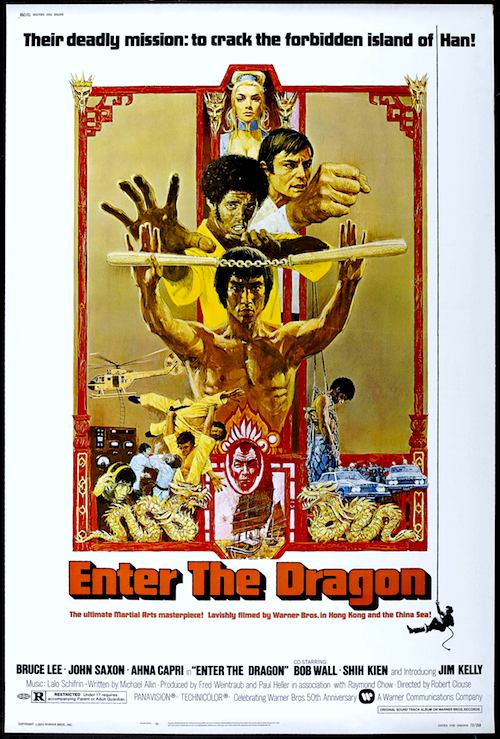By Joe Bendel. It is the first true martial arts film selected for the Library of Congress’s National Film Registry. Bruce Lee’s first Hollywood star vehicle and his final fully completed film represents kung fu cinema at its most cross-overiest, yet it is still legit to the bone. In honor of Ip Man and Wong Kar Wai’s The Grandmaster, Bruce Lee & director Robert Clouse’s Enter the Dragon begins a week of restored DCP screenings today, as part of BAM Cinematek’s Wing Chun classic film series.
Lee’s namesake is a Hong Kong Shaolin standard bearer knocking on the door of complete martial arts enlightenment. While glory in the ring hardly interests him, he agrees to compete in the triannual martial arts tournament sponsored by Han, an international vice lord and general megalomaniac. Sent in by British Intelligence sans back-up, Lee is to reconnoiter around Han’s pleasure palace and hopefully fight his way out of any trouble he might encounter. It is not much of a plan, but it will suffice.
The stakes turn out to be unexpectedly personal for Lee. Shortly before embarking, he learns Han’s thugs were responsible for the death of his sister, Su Lin. As one might expect of Lee’s kin, she put up a heck of a fight. Han’s chief enforcer O’Hara still bears his scars from the encounter. He is due for some more pain. However, Lee will meet some friendly Americans en route, such as the well heeled Roper, who is looking to hustle some action to pay off his gambling debts, like a kung fu Fast Eddie Felson. In contrast, Roper’s former Army buddy Williams seems more interested in hedonistic pleasures supplied nightly to the fighters.
 Enter might not sound earthshakingly original, but that is partly a function of how widely imitated it has been, especially the iconic hall of mirrors climax. Scores of movies have copied its general template of the ostensibly upright kumite going on above ground, while armies of henchmen in color-coded gis labor towards nefarious ends below. Without it, there is no way we would have guilty pleasures like the Steve Chase beatdown, Kill and Kill Again, which is a thoroughly depressing thought to contemplate.
Enter might not sound earthshakingly original, but that is partly a function of how widely imitated it has been, especially the iconic hall of mirrors climax. Scores of movies have copied its general template of the ostensibly upright kumite going on above ground, while armies of henchmen in color-coded gis labor towards nefarious ends below. Without it, there is no way we would have guilty pleasures like the Steve Chase beatdown, Kill and Kill Again, which is a thoroughly depressing thought to contemplate.
All the elements come together, but there is still no question this is Lee’s show. Almost supernaturally intense and charismatic, Lee was clearly at the peak of his powers throughout Enter. It is a massively physical performance (featuring some impressive acrobatic feats), yet Lee still takes care to convey the philosophical side of Wing Chun. The restored print includes more scenes of Lee as a spiritual teacher that work quite well.
Even with Lee’s overpowering presence, Enter is the film that really put Jim “Black Belt Jones” Kelly on the map. As Williams, he contributes attitude and energy that further distinguished Enter from its genre predecessors. In fact, the cast is loaded with notables, including John Saxon, hamming it up with relish as Roper. Fans often wonder why so little was subsequently heard of Betty Chung, but she has some nice rapport with Lee as Mei Ling, a fellow undercover operative.
There are also plenty of established and future action stars, most notably Angela Mao absolutely crushing Su Lin’s brief but pivotal flashback scene. Bolo Yeung also appears in exactly the sort of role that would make him famous. Sammo Hung has a briefer turn as a Shaolin martial artist who fairs poorly against Lee—but not nearly as badly as blink-and-you-missed-him Jackie Chan, whose meat-for-the-grinder henchman gets his neck snapped by our hero.
But wait there’s more, including a classic funky eastern fusion soundtrack by Lalo Schifrin that opened up a lot of ears up to the Argentinean composer and former Dizzy Gillespie sideman. Without question, this is a historically and culturally significant film, well worthy of being selected for the National Film Registry. Logically, it anchors BAM’s Wing Chun series in honor of Lee’s revered master, Ip Man. Highly recommended beyond martial arts enthusiasts, Enter the Dragon begins a week long run (8/30-9/5) today at the BAM Rose Cinemas.
LFM GRADE: A
Posted on August 30th, 2013 at 1:24pm.







 Which makes her brief movie career all the more tragic. This is a woman who should have been a bigger movie star, someone who could have been in the sexy/sassy comedienne ranks with Ginger Rogers and Jean Harlow. While her
Which makes her brief movie career all the more tragic. This is a woman who should have been a bigger movie star, someone who could have been in the sexy/sassy comedienne ranks with Ginger Rogers and Jean Harlow. While her 
